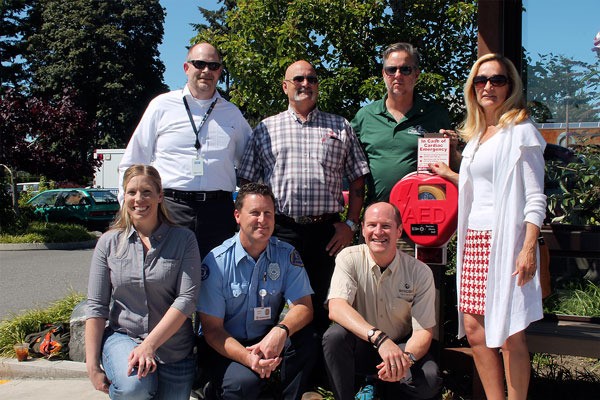Representatives from a slew of Whidbey Island organizations have teamed up to roll out the first of three automated external defibrillators (AEDs) to be located in public places on the South End.
The installment of the AEDs is part of a push from Rotary of Whidbey-Westside, WhidbeyHealth Hospital Foundation and South Whidbey Parks & Rec to bring defibrillators out of business closets and onto the streets for public usage.
The first public defibrillator was unveiled on Wednesday afternoon at the bus stop in front of WiFire in Freeland. Those who were involved in the public health initiative were in attendance to discuss the benefits and longterm impact of placing AEDs in public areas. Rotary Club of Whidbey-Westside President Ashley Morrison was present, as well as South Whidbey Parks and Recreation District Director Doug Coutts, Whidbey Telecom CEO George Henny, WhidbeyHealth Foundation Executive Director Helen Taylor and Robert May from WhidbeyHealth EMS.
Two more AEDs will be placed in Community Park and South Whidbey Sports Complex, respectively, by the end of the month, Coutts said.
Talks of public defibrillators began when Coutts and May discussed the lack of access to the machines during a CPR seminar May was leading at the parks district. The two reached out to Rotary about the possibility of funding a device, and they put the idea in motion.
“Without the Rotary Club and their push to install the defibrillators, this wouldn’t have happened,” Coutts said. “They were the ones that said they were going to make a difference by purchasing one of them.”
From there, the hospital foundation donated an AED and the parks district purchased the casing needed to put the one they already had outdoors. Those involved throughout the process reached out to South Whidbey Fire/EMS to determine the locations where it was most crucial to install the machines. Fire officials located 34 spots on the South End in total where a defibrillator could be used to save a life in the future.
Whidbey Telecom will provide ongoing 911 connectivity for all three sites.
The importance of having the machines in public cannot be underestimated, May said. He says that, according to the Cardiac Arrest Registry to Enhance Survival, 97 percent of all placed AEDs aren’t used in the moments when they are needed.
“Data also shows that having an AED on site increases the chances of survival by three times for sudden cardiac arrest,” May said
Immediate access to a defibrillator is crucial in the event of a heart attack. A news release from Rotary Club of Whidbey-Westside said that, unless treated within minutes, sudden cardiac arrest is fatal for 95 percent of victims.
“In order for people to survive cardiac arrest, there needs to be rapid deployment of electric current and that’s on the citizen level,” South Whidbey Fire/EMS Chief Rusty Palmer said. “It’s absolutely imperative for the public to have immediate access to them.”
Those behind the defibrillator installments don’t think this will stop at three being placed across South Whidbey. Coutts says this has become something that could be expanded since the system is already in place, and it just comes down to funding and those who own defibrillators to offer to place them in the streets. Palmer says AEDs can be purchased at Costco for around $1,500, but can be as low as $1,000.
Coutts pointed out that costs would be halved if defibrillator owners offered to place theirs in the public view, since only the casing would need to be purchased in that instance.
“This is a total community project,” Coutts said. “It doesn’t come down to one entity, and it couldn’t have happened unless everybody was involved.”



